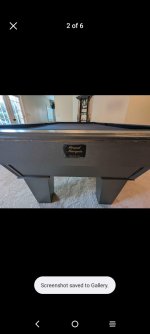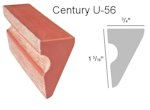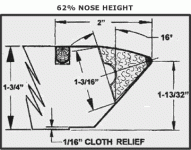I'd measure from the table to the contact area of the ball
this page says it should be 62 1/2 to 64 1/2 percent of the ball size.
Answers to frequently-asked questions about pool table cushion nose height.

billiards.colostate.edu
maybe a pro mechanic can comment on the type of rail and how that may relate to this proportion, but I think this is basically what you are shooting for. my suggestion is to find other references before you glue them on. I've seen some variation in that number quoted. you might want to mount one rail and try bounce tests at different speeds to note the differences in the reaction. If you still have rubber on the old rails you can try some shims to raise the nose height and perceive differences, not easy to lower the height. It's important to get this right the first time.
on the old brunswick 7' I restored it had no reference because the cushions I used were completely different and the originals not available... so I fooled around a bit. found I could place a strip of rubber covered wire under the rail to raise it, or move it towards the outer side of the rail to lower it slightly.. that was just a way to fool around and do tests and see the difference .. after you have them glued on and felt on it wont be fun to change that so I'd experiment a bit to satisfy myself that this will not be a problem later. If you havent covered many rails you cna watch some youtube videos, there are some good ones. one thank Id mention is that if you get your cloth and staples all bunched up it may interfere with how the rail sits, and any "rocking" you want to avoid. your rails may have a hollow to prevent staples and bunched up cloth from interfering with the fit.
different tables have different means of securing and steadying the rails but basically you want a very solid mounting. some rails on older and well made tables have super heavy iron bars in them or bolt into the edge of the slate itself.
If the rail can move upon impact it won't help things. If the rail can rock or move that's bad. the rails may be hardwood or crappy particleboard or pine or whatever, better ones will use decent hardwood but some use particleboard or a softwood such as pine to reduce the price. some tables have no more than bolts to captivate them, others have better means to lock things down in a more solid way. you will notice a reduction in noise from a "bonk" to very silent reaction on better quality tables. other than performance, it makes a good table more pleasurable to play on than a cheapo. You aren't choosing a table now, but mounting the rails, so my comment was basically to make you aware that how they are locked into position is important, as well as the height between ball and contact area. You might need a skirt below the cushion, to fill any gap between the cushion and table surface if there is a gap, or a different style but I'll stay out of that.. Someone that sells the cushions might be a good person to make sure you have the correct profile for the table. If you don't take the time to do this correctly and then want to change it later, you will wish you got it right first. a kludge to make it higher might be to shim the rail higher but that's not preferable. If you are at all unsure of the ball size, I'd check that first too..


